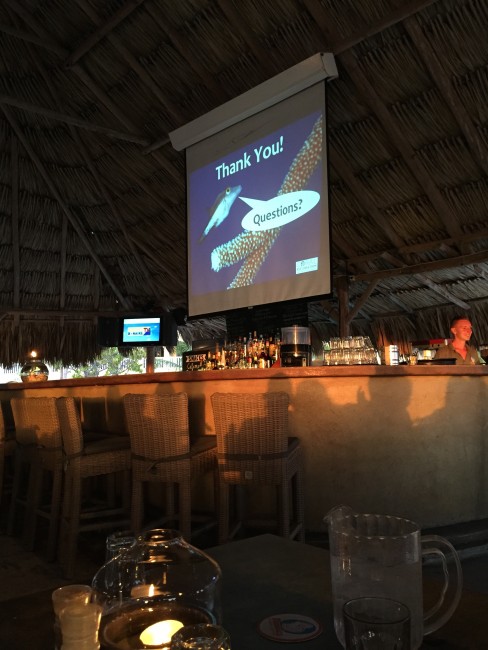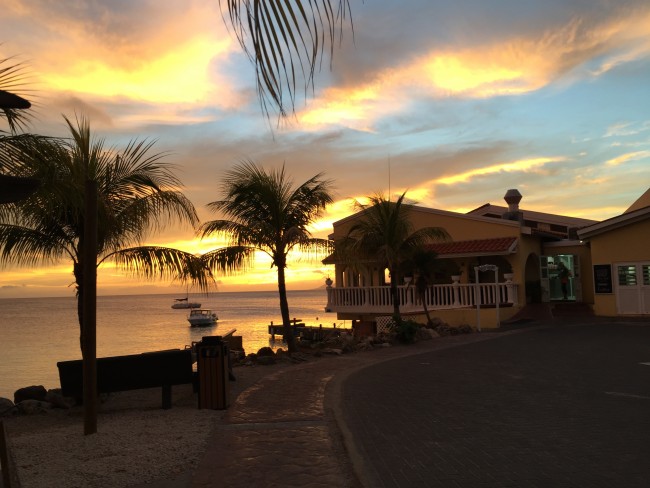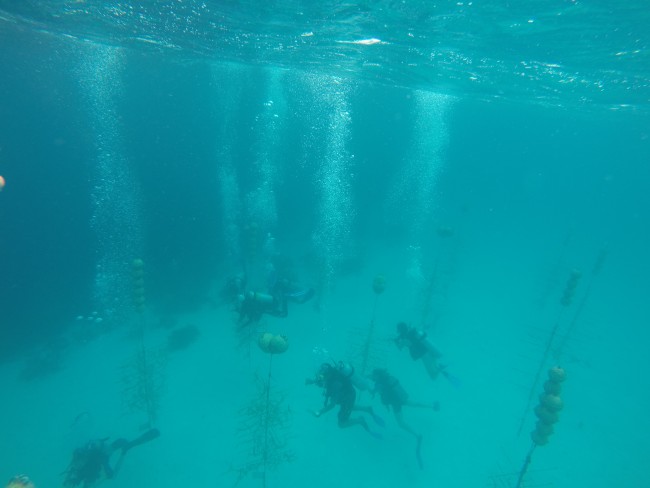On a map with street names, Buddy Dive Resort is on Kaya Gobernador Nicolaas Debrot, but chances are directions will include some hand waving and a “you can’t miss it, it’s the big yellow one.” On Monday nights at Blennies Restaurant and Bar (conveniently located within Buddy Dive Resort), there is a presentation on coral restoration and the work that Coral Restoration Foundation Bonaire (CRFB) does around the island. Each presentation goes through the specific conditions for coral growth in the waters of Bonaire, the science behind coral propagation, and the types of coral the foundation focuses on.
The presentations offer a primer on the work that CRFB does, and hopes to garner support and interest from the people who are an otherwise captive audience at the restaurant. Listeners learn that the foundation’s mission is “to develop affordable, effective strategies for protecting and restoring the shallow water population of staghorn and elkhorn corals along the coastlines of Bonaire and Klein Bonaire.” They also learn that “CRF Bonaire, supported by the local government and the Bonaire Marine Park, is developing a large scale reef restoration program, promoting awareness and engaging tourists and local volunteers.” The foundation is young—created in 2012 after a visit from Ken Nedimyer of CRF’s United States branch to discuss conservation efforts. In February of that year, the government and marine park granted a permit for Buddy Dive to begin its work (CRF Bonaire 2015).

As a leader for young adult scuba service trips on the island this summer, I saw the presentation three times, twice with a group of young adults. Both times, I brought groups for the express purpose of attending the presentation, giving strict instructions not to order anything aside from water; we were the only ones at the outdoor restaurant explicitly paying attention to the speaker.
I saw three different people give these presentations in three consecutive weeks. Yago, a handsome Spaniard with an awareness of his audience, was incredibly personable and often tried to engage us by making jokes and seeking answers to his somewhat rhetorical questions. The second week (which I attended without teenagers), Elena gave the presentation. She attempted some hasty jokes that fell on deaf ears and bulldozed through the scientific terminology with aplomb and novel pronunciation. Elena was Spartan with her words—no nonsense—and seemed as though she could not be done soon enough. She clearly cared about the restoration project but did not know how to address the lack of interest on the part of those dining. All of the coral restoration instructors take turns giving the presentation, as it is not a highly coveted after-hours job. Augusto, the head dive master instructor, gave the third week’s presentation. He struck a balance between Yago’s lighthearted banter and Elena’s direct, to-the-point information. Augusto has been in charge of diving at Buddy Dive for thirteen years and an integral part of the coral restoration endeavor for the past three. All three were highly informative presenters, and they rattled off scientific terms in English despite the fact that it was no one’s native tongue.
For some diners, the presentation disturbed their idyllic sunset dinner, and the presenter made an insincere apology and asked them to be quiet. There are no walls at Blennies, and the roof is thatched palm. It appeals to the tourists who flock here in droves for a rustic, tropical experience. For some guests, the dinner and drinks made them loud distractions. For others, dinner and drinks made them loud participants in the presentation. Either way, it was clear that the informational presentation was a surprise add-on to their tropical meal in paradise. Some were resentful while others embraced the laidback island spirit. Perhaps some of them would go on to get a coral restoration certification once they got tired of the house reef or maybe become curious about the haphazard obstacle course used for training set up under water by the shore. Maybe they would take the pictures of bleached and dying coral to heart and feel compelled to do their part to regenerate swaths of reef.

Bonaire is a small island off the coast of Venezuela and a special municipality (as of 2010) of the Netherlands. It is therefore a common destination for vacationing Dutch, and several of the Dutch dive instructors grew up spending time on the island. The official language is Dutch, the local language is Papiamentu, and most everyone speaks English. The island is one of the top destinations in the world for shore diving, the access and ease of which is (so I’m told) unparalleled. Painted yellow rocks with the names of dive sites dot the roads along the shore, demarking shore dives. Especially along the southwestern shore of the island, it is hard to go more than a few hundred yards without a yellow rock.
Buddy Dive lies along a stretch of road that is home to many resorts that cater to tourists. These resorts provide all the equipment and (for the most part) instruction needed to start diving independently. In order to dive in Bonaire, one must be outfitted with a Stichting Nationale Parken (STINAPA) tag and pay a fee to the marine park. STINAPA is the nongovernmental, not-for-profit National Parks Foundation commissioned by the island government to manage the two protected areas of Bonaire: the Bonaire National Marine Park and the Washington Slagbaai National Park (STINAPA Bonaire 2011). In this way, Bonaire ensures that its natural beauty continues to exist for more tourists to visit. Every diver is therefore literally invested in conservations efforts on the island. Divers who wish to dive on their own must also do a “checkout dive” before getting this tag or diving anywhere else on coastline. They must prove that they are safe divers who will not endanger themselves, the reef, or others. On Saturdays, direct flights arrive from a handful of airports around the United States, as well as from Amsterdam. Sunday mornings at the Buddy Dive dock are hectic affairs tinged with American Southern accents, shouts in Dutch, jokes in Spanish, and slippery feet as the newly arrived prepare for a checkout dive.
Recently, some of the Buddy Dive instructors, representing a smattering of nationalities, created a Professional Association of Diving Instructors (PADI) certification specialty. The organizing certification body of divers around the world has granted its particular means of restoring coral, which is a huge boon. For some people who come to dive, this possibility and almost certainty of another badge and card to put onto their diving resume is a great draw, as divers love to collect specialties. Another tag! Another skill set! For some of these tourists, coral restoration is simply another way to get a dive in. For others, like the kids I brought to the island, the idea of saving the charismatic reefs is what brings them to Bonaire and Buddy Dive.
Coral reefs are tangible, colorful habitats and objects of conservation. The underwater landscape is vast and for the most part far more unknown compared to its terrestrial counterpart. To see pictures of coral reefs at their full resplendence is reminiscent of scenes from Finding Nemo. Perhaps this is part of the allure—to feel as though one is a part of a movie. There may not be many charismatic mega fauna in and among the branches of elkhorn and staghorn coral, but the colors and proximity of the smaller fish are almost enough to make a first-time diver gasp in her mask. Seahorses like to hang on the coral nurseries, and little, awkward trunkfish dart in and out of the branches.

CRF Bonaire’s Facebook page shows fun pictures of newly certified divers, as well as underwater action shots of people cleaning and hanging coral in the nurseries, captioned as “coral lovers,” “coral heroes,” and “brave soldiers of the polyp.” It is interesting to note the age range of people who have gone through the course; the students I led were among the youngest, while most of the others are middle aged and retired. After they leave Bonaire, most of them will not go home to a reef to restore. This has been a once-in-a-lifetime opportunity. Perhaps they will come back, but there isn’t a direct tangible transference of skills and actions that stem from their coral restoration. Instead, they will share their photos with friends, wear the T-shirt they bought at the gift shop, and think about how relaxed they felt on the island. Hopefully the seeds of awareness have been sown, and perhaps at some point they will consider the small dent they have made in a wider global oceanic conservation effort.
Caroline Lowe is a student at the Harvard Graduate School of Education. She graduated from Harvard College with an honors degree in Folklore and Mythology, and her studies focused on the intersection of biology and folklore, specifically the role whales play in Māori culture in New Zealand. She hopes to continue educating people about how to best approach their own interaction with the natural world.
All photos in this post are credited to the author.
References
Coral Restoration Foundation Bonaire. 2015. “About CRF Bonaire.” crfbonaire.org/about-crf-bonaire (accessed 24 August 2015).
STINAPA Bonaire National Parks Foundation. 2011. “STINAPA Bonaire.” stinapa.org (accessed 24 August 2015).
Cite as: Lowe, Caroline. 2015. “Conservation Tourism in Bonaire.” EnviroSocitey. 22 September. www.enviroscoiety.org/2015/09/conservation-tourism-in-bonaire.
